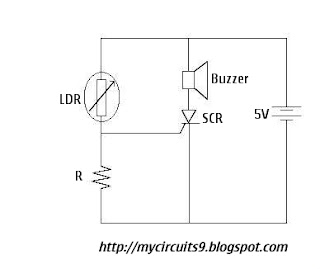OVER LIGHT DETECTOR
Here i am going to Introduce you an Excess light Detector or sensor circuit.
The sensing component used in this circuit is LDR (Light Dependent Resistor).
CIRCUIT DIAGRAM OF OVER LIGHT DETECTOR

Components required to wire up this circuit
1. LDR
2. R - 1K
3. SCR
4. Buzzer
5. 5V BATTERY
WORKING PRINCIPLE OF OVER LIGHT DETECTOR
The LDR is a variable resistor whose resistance decreases with increase in light intensity. When the light falling on an LDR has normal intensity, its Resistance is large enough and the voltage across R is insufficient to trigger the SCR. However, when light falling on LDR is of large intensity, the Resistance of LDR falls and voltage drop across R becames large enough to trigger the SCR. Consequently the buzzer sounds the alarm. It may be noted that if the strong light disappears the buzzer continues to sound the alarm. It is because once the SCR is triggered the gate loses its control.
You can use this circuit as LIGHTNING DETECTOR AND ALARM
Back To HOME For More Projects
Comments
Post a Comment